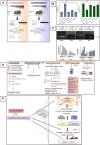Phytotherapeutic options for the treatment of epilepsy: pharmacology, targets, and mechanism of action
- PMID: 38855752
- PMCID: PMC11160429
- DOI: 10.3389/fphar.2024.1403232
Phytotherapeutic options for the treatment of epilepsy: pharmacology, targets, and mechanism of action
Abstract
Epilepsy is one of the most common, severe, chronic, potentially life-shortening neurological disorders, characterized by a persisting predisposition to generate seizures. It affects more than 60 million individuals globally, which is one of the major burdens in seizure-related mortality, comorbidities, disabilities, and cost. Different treatment options have been used for the management of epilepsy. More than 30 drugs have been approved by the US FDA against epilepsy. However, one-quarter of epileptic individuals still show resistance to the current medications. About 90% of individuals in low and middle-income countries do not have access to the current medication. In these countries, plant extracts have been used to treat various diseases, including epilepsy. These medicinal plants have high therapeutic value and contain valuable phytochemicals with diverse biomedical applications. Epilepsy is a multifactorial disease, and therefore, multitarget approaches such as plant extracts or extracted phytochemicals are needed, which can target multiple pathways. Numerous plant extracts and phytochemicals have been shown to treat epilepsy in various animal models by targeting various receptors, enzymes, and metabolic pathways. These extracts and phytochemicals could be used for the treatment of epilepsy in humans in the future; however, further research is needed to study the exact mechanism of action, toxicity, and dosage to reduce their side effects. In this narrative review, we comprehensively summarized the extracts of various plant species and purified phytochemicals isolated from plants, their targets and mechanism of action, and dosage used in various animal models against epilepsy.
Keywords: antagonist, agonist; anticonvulsive; antiepileptic; epilepsy; phytochemicals; plant extracts.
Copyright © 2024 Waris, Ullah, Asim, Ullah, Rajdoula, Bello and Alhumaydhi.
Conflict of interest statement
The authors declare that the research was conducted in the absence of any commercial or financial relationships that could be construed as a potential conflict of interest.
Figures






Similar articles
-
Medicinal plants for epileptic seizures: Phytoconstituents, pharmacology and mechanisms revisited.J Ethnopharmacol. 2024 Feb 10;320:117386. doi: 10.1016/j.jep.2023.117386. Epub 2023 Nov 11. J Ethnopharmacol. 2024. PMID: 37956914 Review.
-
Potential anti-epileptic phytoconstituents: An updated review.J Ethnopharmacol. 2021 Mar 25;268:113565. doi: 10.1016/j.jep.2020.113565. Epub 2020 Nov 7. J Ethnopharmacol. 2021. PMID: 33166627 Review.
-
Herbal Medicine in the Treatment of Epilepsy.Curr Drug Targets. 2021;22(3):356-367. doi: 10.2174/1389450121999201001152221. Curr Drug Targets. 2021. PMID: 33023444 Review.
-
Mechanism of action of certain medicinal plants for the treatment of asthma.J Ethnopharmacol. 2023 Dec 5;317:116828. doi: 10.1016/j.jep.2023.116828. Epub 2023 Jun 25. J Ethnopharmacol. 2023. PMID: 37369335 Review.
-
Anti-seizure activity of African medicinal plants: The identification of bioactive alkaloids from the stem bark of Rauvolfia caffra using an in vivo zebrafish model.J Ethnopharmacol. 2021 Oct 28;279:114282. doi: 10.1016/j.jep.2021.114282. Epub 2021 Jun 10. J Ethnopharmacol. 2021. PMID: 34118342
Cited by
-
A Comprehensive Overview of the Current Status and Advancements in Various Treatment Strategies against Epilepsy.ACS Pharmacol Transl Sci. 2024 Nov 1;7(12):3729-3757. doi: 10.1021/acsptsci.4c00494. eCollection 2024 Dec 13. ACS Pharmacol Transl Sci. 2024. PMID: 39698272 Review.
References
-
- Abdallah S. H., Mostafa N. M., Mohamed M. A. E. H., Nada A. S., Singab A. N. B. (2022). UPLC-ESI-MS/MS profiling and hepatoprotective activities of Stevia leaves extract, butanol fraction and stevioside against radiation-induced toxicity in rats. Nat. Prod. Res. 36 (21), 5619–5625. 10.1080/14786419.2021.2015594 - DOI - PubMed
-
- Abubakar K., Adebisi I., Ugwah-Oguejiofor J., Idris G., Idris B., Mshelia H. (2016). Phytochemical screening and anticonvulsant activity of the residual aqueous fraction of Tapinanthus globiferus growing on Ficus glums. Herb. Med. 2 (2), 1–6. 10.21767/2472-0151.100013 - DOI
-
- Adebayo M., Akinpelu L., Okwuofu E., Ibia D., Lawson-Jack A., Igbe I. (2020). Anticonvulsant, antiamnesic and anxiolytic activities of methanol leaf extract of Bambusa vulgaris (Poaceae) in mice. J. Afr. Assoc. Physiological Sci. 8 (2), 149–157.
Publication types
LinkOut - more resources
Full Text Sources

